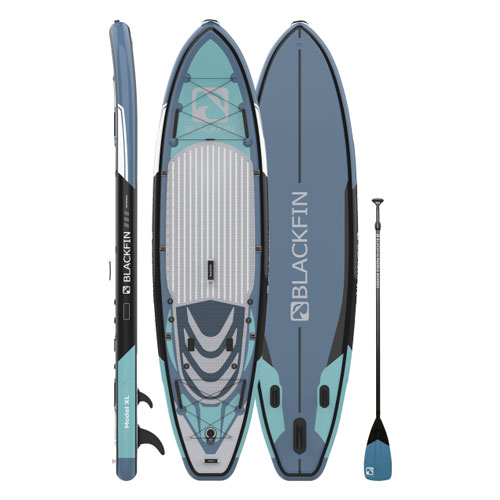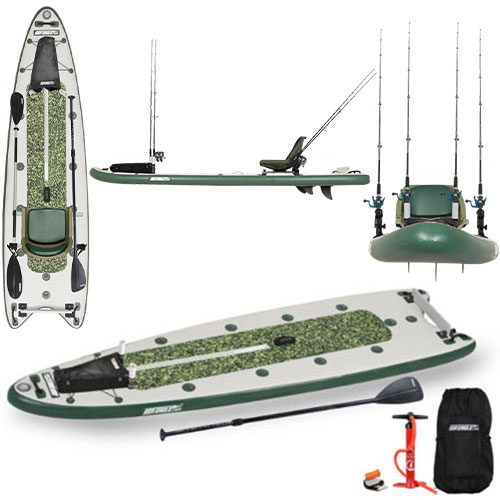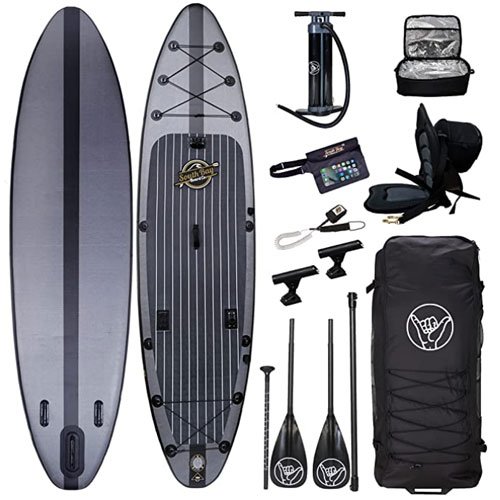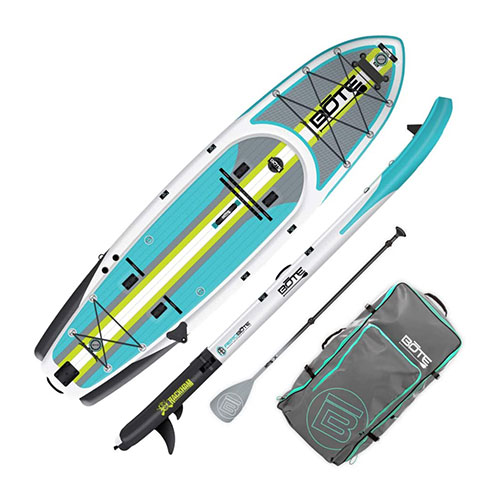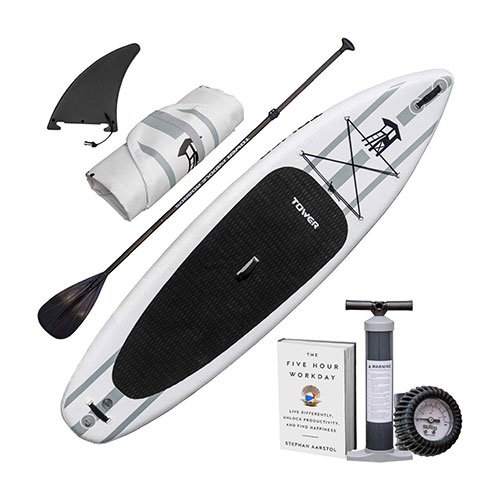Best Beginner Friendly Fishing Paddle Board With Fishing Rod Holders

Paddle boarding has added an entirely new perspective to fishing, making it more exciting and even more productive by enabling you to access fishing spots that you would not with a boat. Furthermore, it is easier to carry around and see fish better while standing.
Undoubtedly, the best fishing sup that is stable, the heavyweight capacity to carry you, your gear, and of course your catch, will make your day even better once you hit the water.
With this in mind, we’ve compiled a list of the best fishing paddle boards in 2023 as well as a comprehensive buying guide to help you out with your decision. Hopefully, with the paddle boards we have selected, you will have a day on the lake with some delicious fresh trout to cook up for dinner.
Best Fishing Paddle Board With 485 lbs Weight Limit
Blackfin Model XL
- Stand Out Features - Why We Love It
- Compatible with a fishing rack
- Very wide and stable
- Super sturdy construction
- Can be converted to double kayak
- Not too heavy to transport
- Included carbon rail for extra rigidity
- Very easy to maneuver
Best for: Sea and lake fishing
Dimensions: 11’6” x 34” x 29”
Material: Triple Layer Composite PVC
Total kit weight: 52 pounds
Maximum allowed weight: 486 pounds
Best Swivel Seat Fishing Paddle Board Rig
FishSUP 126
- Stand Out Features - Why We Love It
- Perfect to use both sitting and standing
- An electric motor can be attached
- Lightweight and easy to carry
- Removable rear skegs for better tracing
- Upturned nose for maneuverability over the waves
- Only takes 7 minutes to be inflated
- Feels super stable on the water
Best for: River and lake fishing
Dimensions: 381 x 102 x 15 cm
Material: 1100 Decitex Reinforced Drop Stitch
Board weight: 20 kg (22 kg with motor)
Maximum allowed weight: 227 kg
Best Beginner Friendly Fishing Paddle Board With Fishing Rod Holders
South Bay Hippocamp
- Stand Out Features - Why We Love It
- Very wide and stable
- Perfect for beginners
- Superb build quality despite low price
- Very quick to deflate and inflated
- Pulled in nose for extra stability when paddling
- Textured no-slip foam deck
- Built in fishing rod holders
Best for: Sea and ocean fishing
Dimensions: 11’6” x 32” x 6”
Material: PVC
Board weight: 60 pounds
Maximum weight limit: 450 pounds
Best Flatwater River Fishing Paddle Board
Bote Rackham Aero Full Trax
- Stand Out Features - Why We Love It
- Excellent combination of stability and speed
- Nice and portable when deflated
- Plenty of room for two people
- Wide surface delivers good balance
- Compatible with Power Rac command center
- Usable with plenty of fishing accessories
- Extremely versatile for fishing
Best for: Any kind of fishing
Dimensions: 12’4” x 38” x 7”
Material: Inflatable AeroBote Technology
Board weight: 45 pounds
Maximum weight limit: 400 pounds
Best Fishing Paddle Board To Bring Your Dog at 12'4
Tower Adventurer 2
- Stand Out Features - Why We Love It
- Very good value for money
- Astounding rigidity when inflated
- Very compact when deflated
- Solid build quality
- Thick board makes you feel extra secure
- Has enough space for two people
- Excellent for beginners
Best for: Fishing on still water
Dimensions: 10’4” x 32” x 6”
Material: PVC
Board weight: 35 pounds
Maximum weight limit: 300 pounds
How To Choose A Fishing Paddle Board – Buying Guide
Using a kayak or a stand up paddle board for fishing has different pros and cons. To clarify, we have listed some of the most major differences between the two. Eventually, the better option comes down to your personal preference, the type of water you will be fishing on, and your fishing style.
Related Post: Paddle Board Fishing
Paddleboard
Pros
- Fishing paddleboards, especially inflatables, are easy to carry and store. You don’t need a large house to store them which means they are better for people in smaller apartments.
- You also have more of an aerial view of the water. Being able to scout the area out allows you to see if you’re in weeds or if there are schools of fish around you.
- Paddleboards allow you to sneak up on your prey. They don’t sit as low in the water like kayaks. Instead, they sit on top of the water which makes them more stealthy.
- You are also able to walk around on your board. If you don’t like the angle of your cast you can simply rotate your body instead of having to move your entire rig.
Cons
- The biggest con to SUP fishing is the lack of storage space. Yes, you will have a bungee system, even two if you’re lucky, but that is still significantly less than in a kayak.
- Your chances of getting wet on a SUP are more likely than that in a kayak. Both require balance, but paddleboards are significantly more vulnerable in the water.
Related Review: Balance Board For Surfing
Kayak
Kayaks are some of the best ways to catch fish as they are extremely portable and easy to use.
Pros
- There is an actual seat that you can relax in. Unlike a stand up paddle board where you have to bring along a kayak seat, kayaks will have a built-in comfortable seat.
- You are also less vulnerable to Mother Nature. You can even bring a blanket for your legs in a sit-inside kayak.
- Kayaks or fishing kayak are also typically more stable than paddleboards. They sit lower in the water and are less likely to tip.
Cons
- You don’t have as good of a view of the water as a SUP. Since you are restricted to a seated position you won’t have the best view of the water.
- Kayaks are much more difficult to carry and get to the beach. You have to own a roof rack or trailer to transport them.
Do’s and Don’ts of SUP Fishing
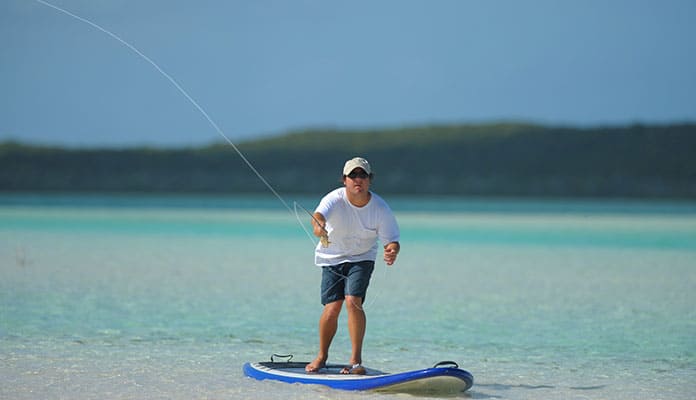
Work With The Weather
Since SUPs sit higher in the water they are more susceptible to the water’s conditions. For example, if it’s windy and the water is choppy your time on the water will be rough. Also, if it’s raining, the deck of your board can become slippery. Tides and currents can also affect how the board acts in the water.
All About The Anchor
Bringing a small, compact, foldable anchor will make worlds of difference when you’re fishing. It takes enough concentration to throw casts without having to keep yourself in position, as well.
Lines
If you are fishing with more than one rod, you want to ensure your lines don’t get crossed. This is quite important especially when you have a big fish at the end of your line. You don’t want to have to deal with a knot that can divide your attention.
Stripping Mat: This is a spiked mat that sits under your feet and works to collect your line as you get your fly. This is especially important when you are going through choppy waters as it keeps your lines from tangling and flying off your board.
Stripping Basket: This is worn around your waist and serves the same purpose as the mat. Choosing between the two can be purely based on personal preference.
Storage
As SUP fishing has grown in popularity, there are many different accessories that you can buy in order to dress your board to your desire. Be sure to see what is available and choose the features you want to have.
You want your gear to be easily accessible while you are paddling as it will allow you to change your fishing gear with ease. In order to make that happen there are two ways, you can pack it. The most popular way to do so is to attach your gear to your SUP deck. Otherwise, you can pack your gear into a carrier and strap it to your back while you paddle, although this can make your time less enjoyable. Regardless, you will want to pack all of your gear in a dry bag to ensure it stays safe.
Choosing your Fishing SUP:
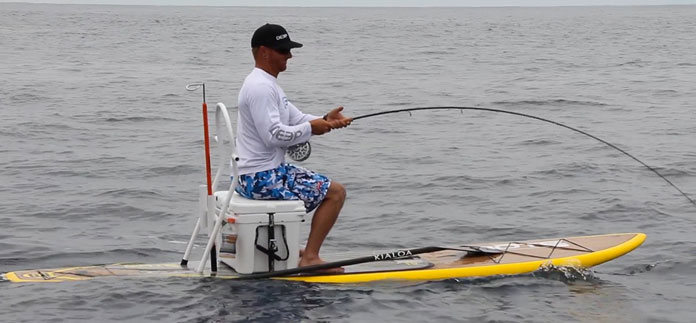
A paddleboard that is good for fishing have features that are different than a standard board. Fishing on a paddleboard is a new twist on an already fun and popular sport. Companies have put time and money to design paddle boards for fishing that specialize in this new activity. When looking to buy the best fishing sup we recommend looking for the following characteristics.
(Hey! You May Also Like: Best Yoga SUP Boards)
Weight Capacity
This will ensure that your board still remains afloat despite having a heavy load on. Nothing is worse than a board that is struggling with buoyancy when you are fishing. Ensure that your inflatable SUPs capacity accounts for your weight, and the weight of all the gear you intend on packing with you.
Board Size
- Width: Fishing on a stand up paddle board can be tricky if you don’t have the balance and stability to throw the perfect cast. A wide board, 30 inches or more, not only gives you the stability but also allows you to get into the right stance. Also, it will give you the confidence to ride in choppy weather.
- Thickness: The height of the fishing sup board also comes into play when fishing. Stand up paddle boards that are around 6 inches thick ride high enough that no water will crest the board, ensuring that your feet will not get wet even if you are only wearing socks. A thicker board will also not flex when going over choppy water. Keep in mind that this directly corresponds with the weight capacity as heavier weights onboard sink it more into the water.
- Length: A longer board, when coupled with a wide stance and high frame, creates the ideal fishing sup. The length ensures that you can carry all of your gear and have enough room to move around freely.
Grip
Most boards come with some sort of padding on the board. When fishing, it is important to make sure this is sufficient to stand on. Grip not only allows you to stand comfortably but also makes your tackle and cooler not slide around when in choppy water. Boards nowadays are thick enough.
Foam Pad For Seating
An easily overlooked aspect of even the best fishing sups is the seating area. While stand up paddle boards are typically designed for standing, when using for fishing you will spend quite a bit of time sitting and you want to be comfortable doing it. Paddleboards typically come with a foam nonslip pad that acts as a foam comfort pad to sit on. Some paddleboards even go as far as to have a seat back that will provide back support while you fish.
You might also be interested in:
Materials
Fishing sups come as either a hard material or an inflatable “soft” material. Often we associate items made from hard materials to be the most durable but this isn’t the case with fishing paddleboards.
Hard materials typically refer to any sort of foam or hard plastic design where the board is rigid and does not collapse in size. These boards ride rigid and are excellent for beginners or those that need more stability. They also typically come with large non-slip foam pads for added grip.
Inflatable fishing paddle boards are made using incredibly high-quality PVC that is sometimes military grade. They do not dent, bend or crack and collapse to fit into a backpack. Often riding like a rigid board, these boards are strong enough to bring your pup on board without fear of his nails causing damage.
Paddle Holder
Having a board equipped with a space to hold your paddles while you fish provides much-needed peace of mind. Having to hold onto your paddle while you are fishing can prove extremely inconvenient and take away from your experience. If your board doesn’t have a designated space for this, buying a paddle that comes apart into smaller pieces that you can store under a bungee strap will have the same effect.
Storage Space
This can be as simple as some D-rings or as fancy as an enclosed cargo bay but never undervalue the usefulness of having storage space on the board. Having an enclosed storage bay is ideal, as it can be turned into a cooler. Having a place to store your fishing poles and tackle will give you peace of mind while fishing.
Warranty
One way to tell the quality of a stand up paddle board, and the confidence of the company, is to see how long they will warranty a board for. A one-year material warranty is standard, but some companies include a money-back guarantee and a warranty that stretches up to two or even three years.
FAQs
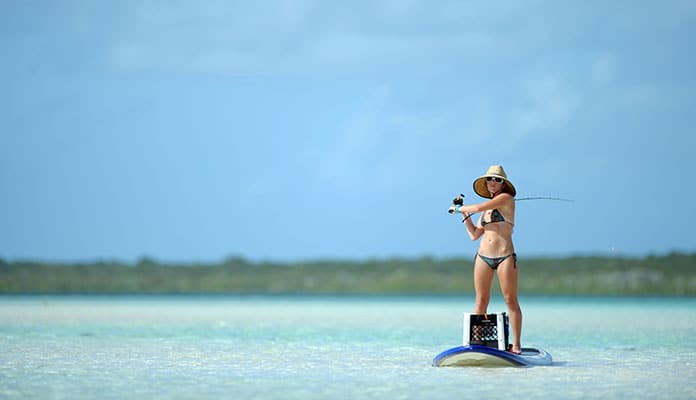
Q: How to trick out a paddle board for fishing?
There are many things you can do to get your paddleboard tricked out for fishing. A cooler can become the perfect seat while also keeping your beverages and food nice and cold. Some also have rod holders that can hold your rod and fishing net when you’re paddling out.
A lightweight anchor can also hold you in place while not taking up a lot of storage space. You should also plan to have a waterproof backpack strapped to your paddleboards rigging. These handy pieces of gear make a watertight seal which allows you to bring your camera gear to get the best photos.
Q: How to stabilize a sup for fishing?
Specially designed fishing SUPs have built-in systems that add stability to your time on the water. If you find that this is still not enough there are inflatable pontoons you can attach to your board which ensure you can walk around without tipping at all. These add-ons make it slightly more difficult to paddle but give you the ability to go out even in rough waters with ease.
We strongly recommend boards that are at least 6 inches thick to fish on. This gives you the capacity you need for all your gear. It also ensures that you can sit above the water without getting your feet wet. This may not sound like a big deal but it will allow you to take out your board even in the winter.
Q: Where do you put fish when sup fishing?
Many people bring along a garbage bag that they put in their cooler. This keeps your catch separate from your food and beverage while keeping it cold. Other people like to bring along a separate bucket, especially for their catch. The only issue with this is that it can heat it up if you spend the entire day on the water.
Q: Where to put sup paddle when fishing?
If you are planning on using your SUP to fish we suggest getting paddle clips. This attaches to a part of your boat and allows you to strap your paddle to it. You can then use both hands to get set up and throw the perfect casts without your paddle floating away or balancing precariously on your board.
Globo Surf Overview
Paddleboarding can be a very serene and meditative hobby, as is fishing, so it makes sense that these two can be combined. To ensure you get the most out of this fun and relaxing excursion, ensure that you pick one of the excellent fishing paddle boards. Thankfully, fishing sups are quickly becoming a popular trend and companies are putting more focus to ensure that their boards meet your standards. Luckily, all of the boards on our list are excellent for both sup use as well as to catch fish.



